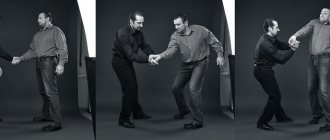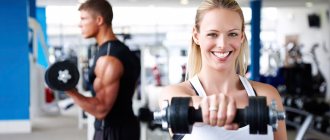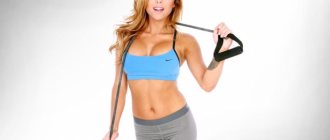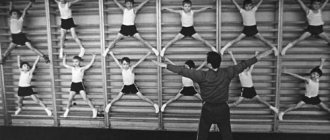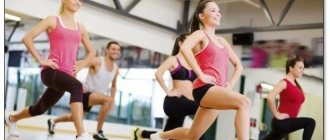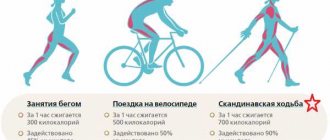You spend several hours every day in the gym, know all the equipment inside and out, and feel at home among tons of hardware. But do you know how often you really need it? The answer may surprise you! Find out your optimal training frequency to make new gains.
You probably already guessed that the main mistake is with the wrong frequency. The most common training schedule is “three days a week”: you train on Monday, Wednesday and Friday. If this is your case, there's good news: you can do much, much better!
Even if you're doing great in the gym—the number of reps and sets, the optimal weight, rest between sets, and proper exercise execution—it can all be useless if you don't train at the right frequency.
Why do a warm-up?
By warming up before training, we get a wide range of benefits:
- Warming up the muscles. This improves our overall efficiency. It becomes easier to lift weights because warm muscles are more elastic than cold ones. The risk of injury is also reduced.
- Vasodilation occurs. This reduces the load on the heart. Blood flow also increases and our muscles receive more oxygen.
- Prepares the nervous system for hard work. Any physical activity is stressful for your body. Especially hard work in the gym with heavy weights. Therefore, in order to tune your nervous system in the right way, you should warm up.
- Warming up joints and ligaments. With a sedentary lifestyle, our joints lose their elasticity. And before you start training, it won’t hurt to stretch them. Otherwise, all sorts of problems with the articular-ligamentous apparatus may arise.
- Speeds up metabolism. Warm-up increases hormone levels. Such as: somatropin, dopamine and testosterone. Consequently, your efficiency during training will increase.
That is, in just 5-10 minutes, we will protect muscles and joints from serious injuries. We will also strengthen the cardiovascular system. Warming up helps us prepare the body by letting it understand that now you want to give your best in training. And he is required to be fully involved in the process. An analogy can be made with the operation of a car in winter. Before driving, the engine is warmed up. Due to this, all lubricating fluids become less viscous, and rubber seals are pressed through. That is, we spent a few minutes in order to reduce the wear of parts of our car. Consequently, its service life will be much longer. Warm-up does the same thing.
Repeat ranges and their impact:
- A low rep range - from 1 to 5 - makes the muscles more dense and develops strength.
- The middle range—6 to 12—increases muscle mass and strength equally.
- Large – 13 and more – increases volume and develops strength endurance.
When you vary your rep ranges, you develop all the qualities and achieve a balance between power, strength and endurance.
To avoid a “plateau”—a stop in progress—the same exercise is performed in different ranges and the working weight is increased. Use this principle when building a self-training program in the gym.
For example, dumbbell bench press:
- 30 kg – 12 repetitions with rest 90 seconds;
- 32 kg – 10 repetitions with rest 90 seconds;
- 34 kg – 8 repetitions with rest 90 seconds;
- 36 kg - 6 repetitions.
What are the consequences of not warming up?
If we don't warm up before training, the risk of getting a muscle strain increases. After all, when cold, they are less elastic. It is also very easy to injure joints, which can lead to:
- Arthritis. That is, the joint wears out and the condition of the cartilage at the ends of the bone deteriorates. All this is accompanied by pain.
- Bursitis. This is an inflammation of the synovial bursae, which are designed to lubricate the joints. Elbows and shoulders are especially susceptible to bursitis.
- Tandinite. This is inflammation of the tendon due to excessive strain.
If you constantly ignore warming up, then your cardiovascular system may be under attack. And the heart is the main organ in our body. Therefore, it should also be trained. And if we suddenly switch to an increased pace of work without warming up. Our heart will begin to experience greater stress. Since he will have to sharply adapt to a new rhythm.
What muscles can be trained in one session?
This question interests any beginner who decides to start actively practicing. The workout can include working out any muscle groups. However, it is important to take into account recovery periods, as well as the working time of different types of muscles. Some groups require a greater load, while others require less energy to pump.
We also take into account the rule: when training muscle ligaments, we always start with the largest group. Muscles in descending order:
- Legs.
- Back.
- Breast.
- Deltoid muscles.
- Triceps.
- Biceps.
What to do if the format of one lesson involves working out two muscle groups? In this case, a similar rule applies. For example, if you need to pump up your back and chest, we start with the largest part. However, professional trainers do not recommend doing this. It is best to combine large and small groups: chest and arms, back and deltoids. But they always train separately.
Warm-up rules
In order for the warm-up to give maximum results, you need to understand the principle by which exercises are selected. We don't have to spend all our energy at this stage. Here are a few rules:
- Warm-up doesn't have to be very difficult. It is worth choosing simple exercises. Since not every person can handle jumping or push-ups.
- The duration of the warm-up depends on age. Over the years, our muscles become less elastic, and our joints are no longer as mobile. Therefore, the risk of injury after 40 years is much greater than in earlier years. Consequently, the older we are, the longer it takes to warm up the body. Athletes under 40 years old will need 5-15 minutes to warm up. And above this age, from 15 minutes until the body feels completely ready to work.
- Body type also plays an important role. We are talking about overweight people. For them, many exercises can be very difficult. Therefore, individual warm-up programs are selected for such athletes.
- It depends on what muscles we train on a given day. That is, if you have a day of training the pectoral muscles, then paying much attention to warming up your knees will not be entirely rational. It is much more logical to concentrate on warming up the shoulder and elbow joints. Conversely, on leg day, warming up your lower body will be a priority.
If you take into account all these points during the warm-up, then its effectiveness will be much greater. Than if you do it for show.
We can also divide warm-ups into three types:
- General. Performed at the beginning of the workout. This is a kind of small gymnastics for all parts of the body. It mainly consists of bending and turning the body, as well as rotational movements. We start warming up from top to bottom. That is, we start with the neck and end with the calves and feet. The main thing is not to forget about the emphasis on those muscles and joints that will actively work on a given training day. All movements must be controlled. Perform 20-40 repetitions of each exercise.
- Specialized. It is aimed at additional warming up those muscles that will participate in the work. That is, these are our warm-up approaches. Depending on how intensely you train and the weight of the weights you use, the number of such approaches will be selected.
- Stretching. When doing strength training, you should not stretch before training. Because this will lead to muscle relaxation. But we need, on the contrary, so that they move from rest mode to work mode. But at the end of the workout, stretching will be very useful. But this is a topic for a completely different article.
Now it remains to choose the exercises that can be most useful for us.
Bodymaster.ru recommends Fitness Trainers:
3 signs of overtraining and how to solve them
- The weight used in each exercise does not increase
- Strength training is primarily about progressive overload. This means you should return to the gym fully recovered and lift slightly heavier weights than you lifted during your last workout.
- The number of repetitions or static hold time in each exercise does not increase
If your exercise weight has not increased (see above), then the number of repetitions or static hold time should increase. Recent research shows that increasing the duration of a static hold to 12 seconds produces less benefit than increasing the weight with a shorter hold time.
Taking sports supplements - creatine, arginine, intra-workout, bcaa amino acid and pre-workout complexes will help you increase your strength. These sports nutrition products are specifically formulated to improve performance in sports and fitness for men and women. Just add it to your diet and go ahead to conquer new heights!
Exercises for general warm-up
Of course, there are a lot of warm-up exercises. And it’s unlikely to be possible to list everything. Therefore, I will list only the most popular ones. Most of them are familiar to you from physical education lessons.
Cervical spine
Head tilts
This exercise is performed standing. The back should be straight, shoulders down, neck muscles relaxed. Lower your head, trying to reach your chin to your chest. At the same time, we move our shoulders forward and round our back. Then we tilt our heads back. And we spread our shoulders, sticking our chest forward. Afterwards, we tilt to one side, trying to reach our ear with our shoulder. We do 10-15 such tilts in each direction.
Circular head rotations
The position for the exercise is the same. Lower your shoulders and relax your neck. We begin to rotate our head clockwise and counterclockwise. We do 10-15 repetitions in each direction. We try to perform circular rotations at full amplitude.
Shoulder muscles
Shoulder Raise
From the starting position described above, we begin to raise our shoulders up. The main task is to try to raise them as close to the ears as possible. This exercise is similar to SHRUGS, but is performed without weight. The number of repetitions is at least 20.
Shoulder rotations
Now we complicate the exercise a little and begin to rotate our shoulders clockwise and counterclockwise. Don’t forget to bend and move your deltoids forward and back. This will give us the opportunity to work at maximum amplitude. Also, we do at least 20 repetitions.
Circular rotations with hands
Again, we make the exercise a little more difficult by straightening your arms completely. Now we are working as much as possible on warming up the shoulder joints. You can rotate your hands either clockwise or counterclockwise.
Arm muscles
Forearm rotations
Spread your arms out to the sides and bend them. From this position, we begin to rotate our forearms in different directions. Just don't just wave your arms. Movements should be at an average pace and completely under your control. We perform 20-30 repetitions in each direction.
Rotations in the hands
There are two options here:
- Raise your arms to the sides and rotate your hands clockwise and counterclockwise.
- Clasp your palms, placing them on top of each other. And we rotate them in different directions.
We also do 20-30 repetitions.
Warm up the pectoral muscles
Raising arms to the side with a turn
This is an excellent exercise that warms up not only the pectoral muscles, but also the oblique abdominal muscles. Stand up straight. Feet shoulder width apart. Bend your elbows and place them in front of you so that the fingertips of your two hands touch. We take in air, filling the chest with it. We make a turn in any direction and spread our arms to the sides. We do 10-15 times in each direction. In this exercise, you can make slightly jerky movements at the time of extension. This will give more effect.
Warm up your back and core muscles
Four-way tilts
This exercise will warm up your back and abdominal muscles. Stand up straight. Place your feet slightly narrower than shoulder width. We place our hands on our sides. From this position we lean forward. Then we bend back as far as possible. Next, we tilt to the right and then to the left. The number of repetitions is at least 10 times.
Circular movements of the pelvis
Let's stand up straight. We put our hands on the belt. Feet shoulder width apart. We begin to rotate the pelvis clockwise. Having made a full circle, we change the direction of movement. We try to work at full amplitude. That is, we draw the largest possible circle with our pelvis. Do it at least 20 times in each direction.
Leg warm-up
Hip rotation
We stand straight. We lean with one hand on any ledge for greater stability. Bend the opposite leg and lift it up. From this position, we begin to rotate in any direction. Then we change legs. We do 10-15 times on each leg.
Bent over knee rotation
We place our feet shoulder-width apart. We lean forward and place our palms on our knees. From this position, using your hands, we begin to rotate your knees in both directions. We do this 10-15 times in each direction.
Squats without weight
Feet shoulder width apart. We put our hands in front of us. During a squat, we try to move the pelvis back as much as possible. We do it at least 20 times.
Calf raise
We stand straight. Feet hip-width apart. Hands on waist. From this position, we rise up onto our toes as much as possible, contracting the calf muscles. We return to the starting position slowly and under control. We do it at least 20 times.
These exercises are simple, but very effective. If you don't know where to start warming up, you can use the above example.
To illustrate how the warm-up is performed, I suggest watching the video:
As a result, we highlight the basic rules for drawing up a training program:
- Train 2-3 times a week. Recover between workouts for 1-3 days.
- Always do a warm-up.
- Perform 1 exercise for each of the main muscle groups.
- Do 3-5 working approaches.
- Determine experimentally the number of repetitions and the duration of rest pauses between them.
- Vary the exercises from each category, change the number of repetitions, approaches and working weights.
- Increase your cardio load and workout intensity through circuit training.
- Try to stay within 1 hour.
- Do some stretching at the end of your session.
- Record your achievements in your training diary.
Rate this article:
Rating 4.74 [31 vote(s)]
Warm-up mistakes
Replacing joint exercises with cardio
Yes, while running we improve the functioning of the cardiovascular system. Our body is warming up. But we won’t be able to fully stretch our joints by doing cardio. Pay attention to what professional runners do. Do they come and immediately start running? No, at the beginning they properly stretch their joints and ligaments. Since they are the ones most susceptible to injury. And if you work in a gym with heavy weights, the risk is even greater.
Insufficient time devoted to warm-up
You can often see how a person comes into the hall. And it seemed like he started warming up. But with a little waving of his head, arms and pelvis, he completes it. The worst thing is that this athlete can sincerely believe that he has now protected himself from all disastrous consequences. And what opinion might he have when he is injured? “I warmed up before every training session, but I still got injured. Conclusion: it is useless." The worst thing is that he can then cite his experience as an example. And some of the novice athletes will believe it. Therefore, spend enough time warming up. But of course without fanaticism
Warm up only those parts of the body that are loaded during the training day
Of course, it is very important to thoroughly warm up the shoulder joint before the BENCH PRESS. Or on leg day, when we do heavy BAR SQUATS, warm up our knees extra. But this does not mean that you do not need to pay attention to other areas. Don't forget that bench presses also put a lot of strain on your neck. And in the same squats, not only the legs are involved, but also the lower back. Therefore, we warm up the whole body, focusing on those areas that will be more loaded as part of the training program.
Remember, it’s better to warm up, but not have time to practice. How to exercise and forget to warm up. Yes, medicine has come a long way. Now both ligaments and joints can be replaced. But such an operation is unlikely to allow you to live as before. Therefore, you need to take care of your body. And a little warm-up before training will help you with this. You can also perform it in the morning, or after long sedentary work. And believe me, you will feel a surge of strength.
Good luck to everyone in your training!
How to choose a working weight?
The correct working weight is the one with which you will perform the required number of repetitions and by the end of the set you will have no strength left. It is determined in practice by trial and error.
If you are a beginner athlete or learning a new exercise, perform the movements carefully and do not go all out. If you only do bodyweight exercises, make them more difficult as your form improves.
For example, if you find it easy to do 20 squats, do squats on one leg. This way, you will constantly increase the intensity of your training and improve your training program.
“I need your whole brain”
Surprisingly, this knowledge about the neuromuscular connection has long been tightly integrated into the internal Chinese styles of working with the body - tajiquan, qigong.
Feng Zhiqiang, one of the greatest masters of internal Chinese styles, left behind many students and several texts. One of his students, senior tai chi teacher at “Breathe” and multiple European champion in tui shou Vladimir Sidorov, tells his students during training “I need your whole brain.”
Here is his entire sentence: “Taiji requires the whole mind. When a person finds himself in a state of this movement, he realizes that his entire mind has disappeared somewhere. If we do everything correctly, the mind goes completely, 100% into the sensation of the body, hearing only silence. This is not a shutdown of the brain, but total emptiness; the brain is busy observing these processes.”
And here is what Grandmaster Feng Zhiqiang himself wrote about the connection between thought and movement - about thought-intention:
“In internal styles and qigong, the most important thing is to clearly imagine the action you want to perform, and then it is done.
When you think actively, feel alive, or sense energy in your form, Qi is present. This is very important in our practice - to use the heart and thought. If you are able to direct thought into them while performing movements, then true strength will come to you, the presence of energy will be clearly felt.
Using thought-intention, you strengthen the body, while using only force, you harm the body. Intention means thinking and also includes the concept of Shen, or spirit. If I go to the USA, then my intention goes there first. Then my body. It's important to use intention to guide your whole body.
In the same way, thought-intention moves Qi. Then the whole body can move as if it were one family, together. Where there is thought-intention, there will be Qi and strength.”
I suppose that similar thoughts can be transferred to all the activities that we do in life and that are especially important to us: what we direct our attention to is what develops. Therefore, if you want results from training, do not run your thoughts into information bubbles created by news feeds and your experiences. Instead, direct your attention to the movement of your body.
Maxim Kuderov for Zozhnik
